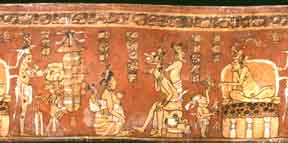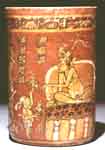Mayavase.com Research Material


Notes on K7727
The imagery on K7727 is a complex variation of a scene from the Hero Twins Cycle, and when taken as a single, unified image represents The Hero Twins in the Court of Itzamná. This scene typically contains fewer figures, and often includes only the Hero Twins presenting an offering to Itzamná (see K1607 and K1183). On K7727, the composition is framed by inward facing figures, and includes the required characters and offering. Hunahpú stands at the far left, Yax Balam/Xbalanqué is seated in the center, and Itzamná is located at the far right receiving an offering.
Several other characters are engaged in conversations with the previously mentioned key figures. Hunahpú (named phonetically on his left) converses with and places a stone on the head of a Uinal Toad acting as a Merchant. The Uinal Toad, identifiable by the God C face on his back, carries a burden topped with a hat on his back. He carries an unidentified object, suggested to be perhaps a collapsible parasol or a canoe paddle. Seated Yax Balam/Xbalanqué holds an animated discussion with a woman, perhaps his grandmother Xmucané, who carries an infant form of the Maize God on her back. Perched on a throne covered with jaguar skin, Itzamná receives an offering of Quetzal from a small figure, perhaps a Baby Hero Twin, who wears a headband identical to the one worn by Hunahpú.
The appearance of the Maize God in three locations is noteworthy. He occurs once as a sacrificial figure seated in a dish on the bundle carried by the Uinal Toad. Simon Martin points out that the fact that he has not yet been sacrificed is an anomaly, and could even be construed as "ominous". The Maize God also appears passively seated (without drawing attention to himself) on the back of his grandmother Xmucané. The most unusual appearance of the Maize God is as the standing figure to the right of Yax Balam/Xbalanque. Although he physically is a part of the central group of figures, his crossed arms and turned head are clear signals that he is not interested in the discussion between Xmucané and Yax Balam/Xbalanque.
Extemporaneous imagery in Maya art is unusual. Each figure and each detail is thoughtfully placed in order to convey specific meaning to the viewer. Assuming this is true for K7727, several questions can be posed. The Maize God appears as a sacrificial offering in a dish, and in this circumstance is typically rendered dead, lifeless, and with his heart clearly cut out. Why is he not only living, but obviously quite alert? Why does the Maize God appear three times in this image, yet does not communicate with any other figure in a scene in which conversation is focal? In the instance of his "full sized" figure, why is his posture so obviously aloof? What role does he play in this image as a recurrently present, yet non-participating character?
On K7727, the Maize God communicates information that aids the viewer in navigating the image correctly. Strategically placed among the other figures, the Maize God serves as a framing device to divide the scene into three distinct paired figures and guides the viewer from pair to pair in the proper order. Additionally, he defines the starting point of the sequence and directs the viewer toward the right.
The Maize God clarifies that the sequence of paired figures (and the text that accompanies each pair) should be examined in a specific order beginning with Hunahpú and the Uinal Toad. The burden carried by the Toad includes a dish and a living version of the sacrificial Maize God, whose open palmed presentational gesture indicates that Hunahpú and the Uinal Toad are the first pair of figures in the sequence. The viewer's eye then moves over the body of the sacrificial Maize God and follows his left arm downward to the second Maize God, located in a sling on the back of Xmucané. The viewer then follows the gaze of the second Maize God, which leads from the left to the central pair of figures. Finally, a full-figured Maize God is grouped with the central pair, Xmucané and Yax Balam/Xbalanqué. In this instance, the Maize God may be tapping into the limited attention span of the viewer. The viewer may relate to the bored appearance of the Maize God as she/he tires of examining the second figure pair. When this occurs the viewer would follow the gaze of the Maize God to the third pair of figures, Itzamná and the small figure presenting an offering of birds.
Conclusion
On K7727, the Maize God appears frequently but is not engaged in conversation with the other characters. His role is not to act within the narrative itself, but is instead to elucidate the structure of the image by organizing the composition into pairs of conversing figures and leading the viewer through their discussions in the proper order. The Maize God may also be reacting to the ability of the viewer to attentively follow the information. He presents the first figure pair with an alert gesture (while the image is fresh and the viewer is still also alert) and presents the final figure pair with seemingly bored mannerisms (as the viewer may also be tiring of looking at the image).
Many thanks to Justin Kerr, Simon Martin, and Karen Bassie for helpful comments that greatly assisted my examination of this ceramic vase during the Austin 2003 Maya Meetings of the Vase Group.
Bibliography
Reents-Budet, Dorie
1994 Painting the Maya Universe. Duke University Press, Durham and London.
Schlesinger, Victoria
2001 Animals and Plants of the Ancient Maya: A Guide. University of Texas Press, Austin.
Taube, Karl A.
1992 The Major Gods of Ancient Yucatán. Studies in Precolumbian Art and Archaeology, 32, Washington, D.C.: Dumbarton Oaks Research Library and Collections.